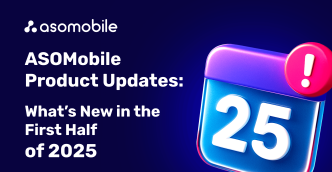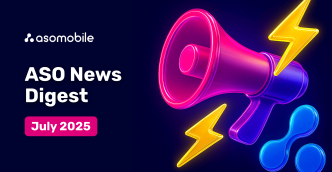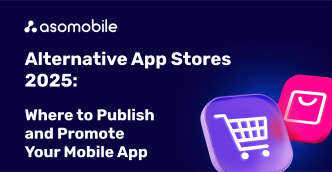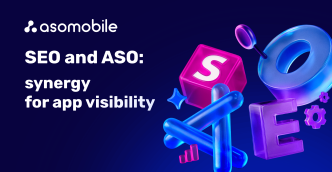ASO in the Food & Drinks Category: Trends and Best Practices for 2025
The mobile app sector within the Food & Drinks category is among the few that not only survived the pandemic era but also experienced explosive growth. Online food and grocery delivery became an indispensable part of daily life when lockdowns forced millions worldwide to stay home. The result was more than a twofold increase in industry revenue compared to pre-pandemic levels.
The Reality of the Food & Drinks App World
In 2023, global revenues from food delivery surpassed $1 trillion, with $ 400 billion attributed to the restaurant delivery segment. The user base for such services continued to grow: in 2024, over 3 billion people worldwide used online food delivery platforms.
Investor interest was swift. Giants like Delivery Hero, Uber Eats, and DoorDash, amid surging demand, secured record funding rounds and actively acquired local startups. Notable deals include the acquisition of Wolt for $8 billion and Postmates for $2.7 billion.
However, following rapid growth came a downturn. Economic recession, rising inflation, and reduced investments in 2022–2023 presented new challenges for the industry. In the U.S. alone, DoorDash laid off over 1,200 employees, and Gopuff more than 2,300.
Nevertheless, the demand for speed and convenience remained. Over 50% of users expect delivery within 30 minutes or less, and "quick commerce" startups like Getir, Gorillas, and Flink strive to meet this demand.
Further evidence of sustained interest in the category is the global downloads of Food & Drinks apps, which reached nearly 2 billion in 2024 – a 11% increase compared to 1.78 billion in 2023. The APAC region, particularly India, was a key driver, influenced by widespread smartphone adoption, active digital integration, and aggressive marketing.
The U.S. ranks second after the Asian region, accounting for over 20% of global app downloads in this category, followed by Europe with approximately 10%.
The total number of apps in this category on Android exceeds 21,000, with an average monthly installation rate of 4.7 million. iOS features over 20,000 apps, with an average monthly installation rate of 31.3 million. As we might have guessed, iPhone users spend 22 times more.
Geography of Food & Drinks App Installations 2024–2025
According to a Sensor Tower report, the distribution of downloads in this category over the past year and the beginning of the current year is as follows:
India – the absolute leader in growth. Download growth: +143%. India demonstrates explosive growth, outpacing all other regions. This result is due to:
- Mass smartphone adoption.
- Rapid digitalization of daily processes;
- Aggressive marketing campaigns by local and international players.
Southeast Asia – steady growth. Growth: +18%. The region is experiencing stable development, driven by growing interest in online delivery and the emergence of local services tailored to user needs.
USA and South Korea – moderate growth. USA: +3.2% and South Korea: +4%. Market saturation slows growth; however, interest persists due to new features, convenient subscriptions, and integration with smart home ecosystems.
Japan – stability. Growth: +2.8%. A slow but positive trend indicates market maturity and a loyal user base.
China is the only region with a decline. Decline: -1.6%. Possible reasons:
- Stricter regulations;
- Competition with integrated super apps (e.g., Meituan, WeChat);
- Potential decrease in user demand amid macroeconomic factors.
What Apps Fall Under the Food & Drinks Category?
Following the rapid growth and transformation of the online delivery market, the Food & Drinks category has expanded significantly beyond just food ordering services. Today, it includes:
- Restaurant food delivery apps (Uber Eats, DoorDash, Glovo)
- Grocery and beverage delivery services (Instacart, Getir, Flink)
- Recipe aggregators and meal planners
- Calorie and diet trackers
- Platforms for table reservations and restaurant reviews
- Apps for barcode scanning and product composition analysis
Each of these subtypes addresses a specific task, from quickly ordering dinner to detailed dietary control. Therefore, the approach to promotion and ASO for such apps will also differ.
Top 5 Food & Drinks Apps by Region
The results of the first quarter of 2025 clearly show that the Food & Drinks app market remains highly fragmented, and success directly depends on adaptation to local tastes.
McDonald's confirms its global status, topping rankings in Europe and Japan. In the USA, DoorDash leads, while in Latin America, iFood is at the top, highlighting the strength of local players. International services like Uber Eats, PedidosYa, and Rappi continue to hold positions in multiple markets, strengthening their presence in the restaurant delivery segment.
In Asia, national platforms confidently lead: Coupang Eats in South Korea, Yakiniku King, and Starbucks in Japan reflect sustained interest in local brands.
The Middle East shows dynamic development in the fast and grocery delivery segment, with KeeTa and Ninja rapidly gaining popularity.
This geographical difference underscores the fact that there are no universal solutions. To enter new markets and grow within the category, developers need flexible localization strategies and adaptation of product value to the cultural and behavioral context of the region.
Conversion Metrics in the Food & Drinks Category
To begin, let's refer to Benchmark indicators – these are average metrics for apps in Google Play and the App Store regarding the ratio of views to installations (we'll consider the last three months of 2025):
For Google Play, the page view-to-install rate is 61.62%.
For the App Store, there are several key indicators:
- Impression to Page Views (% of users who visited the app page) – 4.18%
- Page Views to Units (% of users who installed the app from its page) – 76.5%
- Impression to Units (ratio of impressions to installations) – 3.2%
Note that for Android apps, over 60% of users who opened the app page went on to install it. This result is among the highest across all categories, indicating:
- High user motivation (e.g., hunger is a powerful driver for action),
- Well-designed app pages (icons, screenshots, ratings),
- And likely, strong brands that users trust immediately without much deliberation.
On the iOS platform, statistics show a significant difference between page visits (only 4.18% of users) and installations from the app page, with over 75% of users. Nearly three out of four users who visited the page went on to install the app. This is a very high indicator, confirming:
- Strong Unique Selling Proposition (USP),
- Product relevance,
- High trust in brands within the category.
The final conversion of all who saw the app into installations is modest but regular for the App Store. Here, success heavily depends on the icon, name, and first phrase – they are visible before navigating to the page.
The Food & Drinks category is among the best in terms of conversion at the decision-making stage. If a user has already visited the app page, they are highly likely to install it.
This means that ASO efforts in this niche should focus on increasing click-through rates in search (CTR) by optimizing the icon, name, rating, and first screenshots. These elements influence the transition to the page, where the app effectively closes the deal.
User Behavior Features
Users in the Food & Drinks category act quickly and out of necessity. This means:
- A high share of installations from brand queries
- Low tolerance for complex onboarding processes
- A short decision-making lifecycle - thus, metadata should be as "catchy" as possible at first glance.
Textual ASO Features for the Food & Drinks Category
Textual ASO in this category has its peculiarities - the strength of the brand.
- DoorDash
- McDonald's
- Taco Bell
- Uber Eats
Global market leaders are strong and recognizable brands known even before the app's existence. They don't need to use relevant keywords in the app name - their brand speaks for them. Only giants who have built a user base through their name can afford this.
Subtitles or taglines are not as concise:
- Food Delivery Services – a more general definition, covering both restaurants and food delivery services as a whole.
- Fast Food Chicken Shops – highlights a specific specialization (e.g., KFC) focused on chicken fast food.
- Dining & Restaurants – appears less frequently but emphasizes dining establishments and the possibility of booking or visiting restaurants, especially in South Korea.
Textual ASO in the Food & Drinks category primarily relies on brand recognition rather than keywords in the app name. Major players, such as McDonald's, Uber Eats, and DoorDash, confidently hold top positions without ASO-focused titles; their strength lies in their brand names. However, that doesn't mean textual optimization is no longer relevant. The subtitle serves as a tool for clarifying the app's functionality. It helps store algorithms and new users understand what precisely the product offers. Therefore, for less well-known brands, the key strategy is to structure the subtitle smartly: focusing on the app's features, the type of cuisine, or the service format.
Visual ASO Features for the Food & Drinks Category
Examining the top-downloaded apps in the Food & Drinks category, one thing stands out immediately: simplicity. In 99% of cases, the app icon is simply the brand logo. Brand presence dominates here, too. The logo and brand recognition are paramount; the icon merely signals which service it represents. Screenshots strictly follow brand guidelines, and focus phrases are already familiar to users.
App icons in the Food & Dining category in 2025 reveal a clear visual trend: red is the dominant color. It’s no surprise - red stimulates appetite and has long been used in the fast food industry. Virtually all major brands, including McDonald’s, DoorDash, Burger King, iFood, and KFC, tend to prioritize a red color palette. It is often complemented by yellow or orange colors, which are easy to notice and are associated with warmth and speed.
Delivery services, especially in Asia and Europe, often opt for green, symbolizing freshness, eco-friendliness, and trust. Examples include Grab, Too Good To Go, and Uber Eats. Asian markets are generally more visually diverse: you’ll find blue (Coupang Eats, Catch Table), text on icons, and less recognizable logos.
In the U.S., Europe, and Latin America, it’s simpler: global brands rely on recognition and use minimalist logos without text. Meanwhile, in Japan, South Korea, and the Middle East, you’ll often see more complex icons with captions or additional graphics, visually conveying more information.
Design Techniques:
- Minimalism: Icons like DoorDash, Grab, Uber Eats, and Rappi feature simple shapes, no fine details.
- Brand logos without text: McDonald's, Burger King, and Starbucks utilize recognizable icons that do not require words.
- Text inside the icon: ShopeeFood Driver, Catch Table, Coke ON - mostly in Asian markets.
- Multimodality: Some icons (e.g., ShopeeFood Driver or Allofresh) use both the logo and delivery imagery.
Regional Differences:
- USA and Europe: Dominated by global brands with a focus on logos (McDonald's, DoorDash, Uber Eats)—high recognition, no need for icon text.
- Latin America: Visually close to the U.S., but brands like iFood and Rappi use more vibrant, playful icons, highlighting dynamism and local adaptation.
- South Korea and Japan: Greater color diversity and textual icons, often including symbols, text, and local fonts (e.g., BBQ Chik, Catch Table, Yakiniku King).
- Middle East: A mix of Western and local brands, often with warm colors, minimalism, and simple icons.
Overall, the visual approach reflects the level of brand recognition: the stronger the brand, the simpler the icon. The younger the product, the brighter, more informative, and richer the visuals.
Monetization Trends in Food & Drinks Apps
The Food & Drinks category is not only growing in terms of user base but also showing consistent growth in monetization. In 2025, key trends include:
1. Delivery Subscriptions
A model inspired by streaming services is actively being implemented in food delivery:
- DoorDash – DashPass, Uber Eats Pass, and similar services offer free delivery, reduced fees, and exclusive deals.
- This boosts retention, creates predictable revenue, and strengthens brand loyalty.
2. Paid Priority Slots
Users are increasingly willing to pay for faster delivery or priority time slots. This model is especially relevant in megacities and during peak hours. These extra charges can generate significant revenue with minimal operational costs.
3. In-App Advertising Integrations
Apps are becoming marketplaces for restaurants and brands. Popular formats include:
- Promoting restaurants in search results (similar to ASO within the ecosystem)
- Ad banners and pop-up offers from partners (most often FMCG brands)
4. Promotional Campaigns from Producers
Producers of drinks, snacks, and other goods are increasingly partnering with delivery platforms:
- Promo menus with Coca-Cola, Lay’s, Red Bull
- Discount and promotion integrations based on geolocation
5. Native Purchases in Recipe and Tracking Apps
Apps related to meal planning, recipes, or calorie tracking now include:
- “Buy all ingredients” features linking to grocery delivery
- Paid meal plans and personalized diets using AI algorithms
These models not only increase the average check but also enhance user experience by integrating convenience, speed, and personalization. For ASO, this means one thing: highlight monetization benefits clearly in screenshots, descriptions, and subtitles so users understand what they’re paying for and what they’ll get in return.
Conclusions for the Food & Drinks Category
The Food & Drinks category is a unique blend of speed, brand trust, and strong local presence. You can't rely on name power alone - it’s vital to consider user behavior patterns, tailor the product to each specific market, and constantly maintain visual and textual relevance. Only this way can you remain at the top - both in the rankings and in the user's dish.
 Українська
Українська  Русский
Русский  Español
Español 






